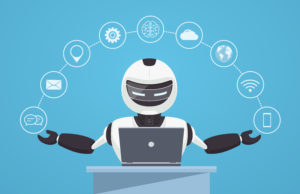
AI Prognostications Plentiful for New Year

(Elnur/Shutterstock)
Artificial intelligence had a breakout year in 2018. The technology seemed to be everywhere, influencing everything from stock trading and hiring to crop rotations and perfumery. So where will AI take us in 2019?
AI predictions feature very prominently in our second roundup of big data and data science predictions for 2019. Here’s a sampling of 13 forecasts from respected leaders in the field:
According to Vitaly Gordon, the vice president of data science for Salesforce, AI is evolving so quickly at the moment that it’s fast becoming a commodity. But does that mean we can take it for granted?
“You do not need to know how the technology of a microwave works in order to use it, it is simply a tool,” Gordon writes. “With the huge influx of no-code, point-and-click tools we are entering into the same phase with AI where it will become a widely used utility by everyone, regardless of technical background. As a result, most of the AI applications in the coming years will be built by people with little or no AI training.
As AI and machine learning advance, companies find themselves under pressure to utilize the technology for profit, writes Dr. Ryohei Fujimaki, the CEO and founder, of dotData.
“While substantial investments are being made into data science across many industries, the scarcity of data science skills and resources limits the advancement of AI and ML projects within organizations,” Fujimaki writes. “In addition, one data science team is only able to execute several projects a year given the iterative nature of the process and the manual work that goes into data preparation and feature engineering. In 2019, data science automation platforms will capture much of the mind share. Data science automation will cover much wider areas than machine learning automation, including data preparation, feature engineering, machine learning and the production of data science pipelines.”
AI might be the ultimate goal for many companies, but they shouldn’t overlook the tough task of data management. According to Couchbase CTO Ravi Mayuram, companies might want to think about standardizing their data management activities.
“The database sprawl will continue as different types of databases proliferate,” Mayuram writes. “App developers are creating a lot of data in a lot of different ways, but it’s all bumping into each other without a servicized solution that offers flexibility to house and manage this data. As it stands, developers are using multiple databases for each individual application, creating a database sprawl as users cobble together multiple databases to plug different holes in the system. While the short-term gain of being able to use emerging technologies and have many choices seems great upfront, companies need to consider their long-term goals, rather than select a cobbled together, quick solution.”
Continuing on the data management theme is Stephan Ewen, the co-founder and CTO of data Artisans, and Project Management Committee member of the Apache Flink project.
“Stream processing will be adopted for complex data management,” Ewen writes. “Rather than using relational databases, stream processors will be able to process ACID transactions directly across streams and states. Like event streams hold the source-of-truth for changes in the world, ACID-compliant stream processing can resolve many streams with overlapping and conflicting changes into a consistent state of the world, at a fraction of the cost and with significantly greater flexibility and ease of deployment.”
The forecast calls for building clouds, according to Arun C. Murthy, CPO and co-founder of Hortonworks.
“Last year was all about enterprises rapidly moving to the cloud, but 2019 will be the year of multi-cloud and hybrid-cloud,” Murthy writes. “Cloud providers will, more aggressively differentiate among each other in specific areas (Amazon: Operational readiness, Microsoft: Enterprise integrations, Google: AI/ML etc.) to avoid a race to bottom scenarios. Enterprises will adapt with multi-cloud strategies to leverage each of the above differentiators by adopting common security, governance and data/workload management strategies – in several cases powered by open-source standards – to thrive and differentiate. We will also start to see enterprises move some always-on workloads from the cloud back on-prem for a hybrid model to optimize economics.”
The growing sophistication of AI will lift all boats – including, unfortunately, the ones the fraudsters are floating around in, says Atif Kureishy, Teradata‘s vice president global emerging practices.
“Synthetic identify fraud will continue to be a significant concern for a majority of companies involved in electronic payment,” Kureishy writes. “Many will have experimented using machine learning and several will have demonstrated improved performance over rules-based systems. A majority of those companies will also have recognized the need to integrate information across different lines of business (e.g., HELOC, small business credit card, consumer credit) to enable early detection of fraud patterns using deep learning to better detect complex signals. Virtually all of companies will be challenged to deploy their new models due to operational and compliance issues dealing unless they can solve their model lifecycle and model risk management strategies.
If AI is a major topic in 2019 predictions, cloud has to be a close second. This next prediction comes from Zoomdata, which sees a veritable stampede to the cloud next year. Yee-haw!
“We’re experiencing a massive stampede of all big data into cloud,” the company writes. “Like a giant tribe of wildebeests, we have found the watering hole (the cloud) and we’ll be setting up camp here for a long time to come. The benefit of this large crowd is that we can share information with all the other wildebeests around the watering hole, a single global database of knowledge, making collective information more valuable. This may sound simple, but it is a transformational advantage. With data sharing, nothing needs to be extracted, transmitted, loaded, or maintained, nor does a company need to incur the costs of their suppliers’ or partners’ BI. Skipping the copying, extraction, and transmission of data to partners and customers makes things simpler.”
AI is automating some tasks, and there will be some job losses. But widespread AI adoption in 2019 won’t translate into large-scale replacement of human beings with AI, according to Nick Mehta, the CEO of Gainsight.
“Despite public opinion, AI will not replace humans in 2019,” Mehta writes. “On the contrary, it will create more opportunities, new skill sets, and make both work and personal lives better. In fact, The World Economic Forum reported that machines will create 58 million more jobs than they displace by 2022. Companies are using AI to handle manual tasks or address customers’ basic questions and requests, but it has not gone to the level of replacing people for handling higher-level questions. From a product point of view, this means taking a lot of the friction points out of the day-to-day work effort that knowledge workers face today and unlocking more time for proactivity with customers.”
One of the most highly anticipated new technologies to debut in 2019 is 5G, the new mobile network standard that will deliver data transfer speeds up to 20Gbps. All that speed equals a billion-dollar opportunity for app developers, predicts Sally Bament, vice president of service provider marketing at Juniper Networks.
“The first smartphones and eventually LTE networks paved the way for mobile apps as we know them, giving rise to a multitude of new ways companies interact with customers,” Bament writes. “5G is poised to go live in many cities across the United States and globally in 2019, and we expect next year to really showcase the economic power of the new mobile technology. This is the year apps start to show their real value in the enterprise and industrial space with a host of new IoT, AR/VR, digital twins and connected-car applications coming to life.”
We’ll get better at deploying AI into the world next year – particularly when it involves machine learning on the network, according to Sastry Malladi, the CTO of FogHorn.
“Moving ML to the edge is not simply a matter of changing where the processing happens,” Malladi writes. “The majority of ML models in use today were designed with the assumption of cloud computing capacity, run time and compute. Since these assumptions do not hold true at the edge, ML models must be adapted for the new environment. In other words, they need to be “edge-ified.” In 2019, “real edge” solutions will enable relocating the data pre- and post-processing from the ML models to a complex event processor, shrinking them by up to 80% and enabling the models to be pushed much closer to the data source. This process is called edgification, which will drive adoption of more powerful edge computing and IIoT applications overall.”
Another recurring theme for 2019 will be an increased focus on data governance. Langley Eide, the chief strategy officer at Alteryx, gives her take.
“Data governance and cataloging emerged as common buzzwords this past year and in 2019, will continue to be major areas of focus for large organizations, as they exist within the critical handoff between the data management or platform teams in IT, and the Center of Excellence (COE) and analyst community that work on the analytic use cases,” Eide writes. “Traditional data cataloging solutions do the heavy lifting in IT, but organizations now see the advantage in helping analysts from different silos of the business—geographic, departmental, etc.—come together to interact with both the data and each other at the level of business understanding. This type of social collaboration, involving the business user, is critical for advancing data strategies and will help organizations look beyond their own corporate data assets to second- and third-party sources that can enrich the respective case.
Big companies that haven’t gotten started with AI yet are behind the eight ball, according to Nathaniel Gates, the CEO and co-founder Alegion.
“Fortune 100 companies are testing the AI waters and experimenting with what is possible,” Gates writes. “As the benefits of AI become a reality, we predict they will start cannon-balling into the pool with fully equipped and resourced data science labs. As this happens, we’ll all start to see Fortune 100’s putting well-tested AI projects into production.
The confluence of micro services, containers, and databases will create value for those charged with managing big data, according to Patrick McFadin, vice president of developer relations for DataStax.
“People are moving over to using microservices for their new applications,” McFadin writes. “They can develop specific components that do jobs really well, and they can scale those jobs up quickly if they are successful. However, all those components create data that has to go somewhere. With stateless application components, you have to put that data somewhere. One consideration is running stateful container instances that can store data over time. I don’t think that gets the most out of containers, or out of the data. Running a database instead makes much more sense. In 2019, I think we’ll see more understanding of where databases can meet specific needs for applications, and more importantly where they can provide this without needing application rewrites.”
Unrealistically high expectations around AI could lead us to take a step back, and possibly reconsider our approaches – not to mention the definition of AI itself, according to Neil Kinson, chief of staff at Redwood Software.
“After early exploration and investments with limited ROI to show, the hype and myths that surround AI are evaporating,” Kinson writes. “2019 will see businesses give themselves a reality check on AI and set more realistic and meaningful expectations for their return on investment. While chatbots have become increasingly prevalent in customer service and internal processes, predictive analytics and machine learning amongst other technologies have also come to fall under the AI umbrella. As this definition expands, and artificial intelligence becomes more closely aligned with augmented intelligence, 2019 will see businesses uncover and implement more AI use cases that bring tangible, measurable value to their organizations.”
Related Items:
What’s Up with 2019? Big Data Predictions
2018: A Big Data Year in Review
2018 Predictions: Opening the Big Data Floodgates

































